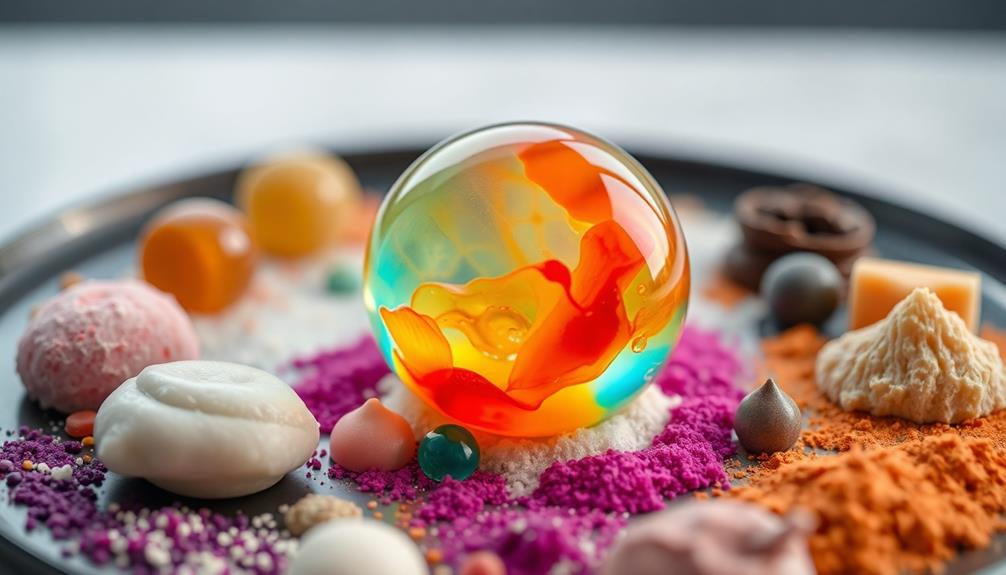Mouthfeel's a crucial aspect of molecular gastronomy, directly influencing your taste and enjoyment. It's all about the textures you experience—creamy, crunchy, or velvety. Factors like temperature and size of fat droplets change how you perceive textures. Saliva plays a key role, providing lubrication and enhancing flavors. This unique combination of sensations can evoke strong emotional responses, shaping your preferences. By manipulating these components, chefs can create unforgettable dining experiences. If you're curious about how innovative techniques enhance mouthfeel even further, there's plenty more to explore in this fascinating culinary world.
Key Takeaways
- Molecular gastronomy utilizes scientific techniques to manipulate textures, enhancing mouthfeel through methods like spherification and foaming.
- Emulsification techniques create stable mixtures that achieve creamy textures, elevating the overall sensory experience in dishes.
- Sous vide cooking allows precise temperature control, resulting in tender textures that enhance mouthfeel and flavor release.
- Textural contrasts, such as pairing crispy and creamy elements, create memorable dining experiences by stimulating varied sensory responses.
- Understanding salivary properties and their influence on texture perception helps chefs innovate and tailor dishes to enhance mouthfeel enjoyment.
Understanding Mouthfeel
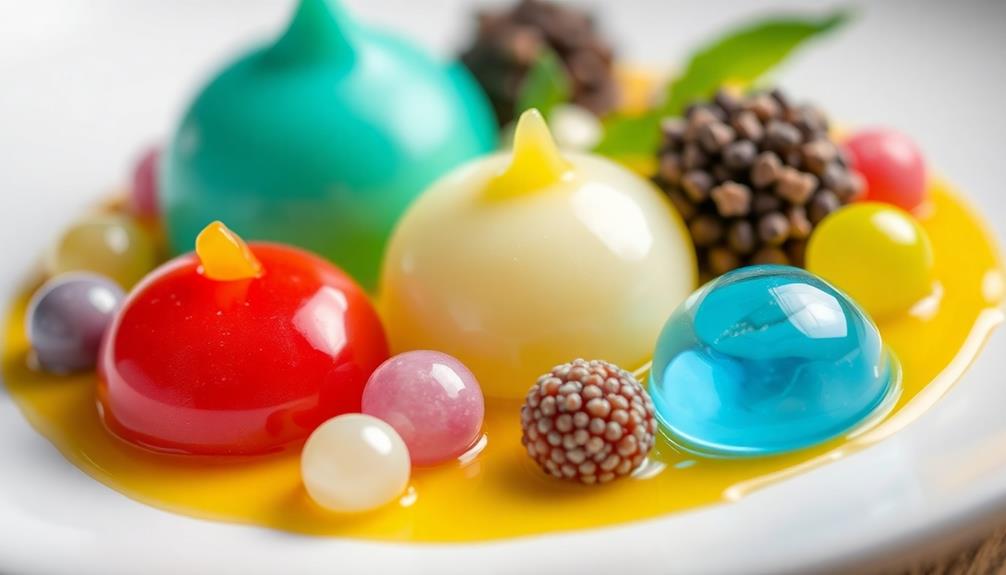
When you dig into the world of food and drink, mouthfeel often takes center stage, influencing your overall experience. Mouthfeel refers to the tactile sensations you encounter during food and drink consumption, including texture, viscosity, and temperature. These sensations play important roles in how you perceive flavors and enjoy meals.
For example, the creamy texture of Chinese Steamed Egg showcases how mouthfeel can elevate a dish. Your oral cavity is filled with various receptors—mechanoreceptors, thermoreceptors, and nociceptors—that interact to create sensations like creaminess or astringency.
Saliva's role in mouthfeel is essential; it forms a lubricating layer in your mouth, interacting with food components and altering flavor perception. For instance, when you sip red wine, the astringency from condensed tannins may create a dry feeling, affecting how you experience the wine's overall flavor.
This intricate dance of sensory input shapes your culinary experience, determining whether you find a dish delightful or unappealing. Understanding the mouthfeel of food is fundamental for enhancing consumer acceptance and enjoyment, as it considerably contributes to your overall flavor perception.
Factors Influencing Astringency
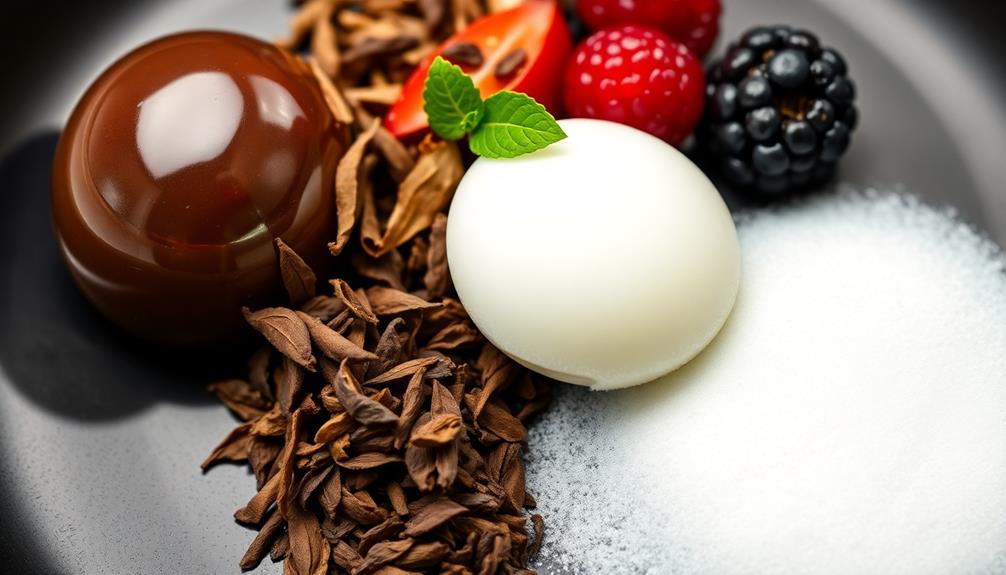
Understanding the factors influencing astringency can enhance your appreciation of various foods and beverages. Astringency primarily arises from the binding of phenolic compounds, especially flavonoid tannins, to salivary proteins, creating a puckering sensation in your mouth. This effect develops slowly and lingers longer than bitterness, which hits your taste buds immediately.
For instance, white wines like Txakoli are known for their high acidity, which can amplify the drying feeling associated with astringency, making them ideal pairings for light dishes and seafood.
Several factors can affect how you perceive astringency. For example, pH levels play a significant role; higher acidity, like in certain white wines, can amplify that drying feeling. Temperature also matters—warmer beverages can alter your perception of astringency.
Additionally, the concentration of phenolic compounds directly influences intensity; more tannins usually mean stronger astringency. Ethanol content in drinks can heighten this sensation too. Studies show that alcohol intensifies the interaction between tannins and your oral receptors, making that astringent feel even more pronounced.
Saliva's Role in Texture
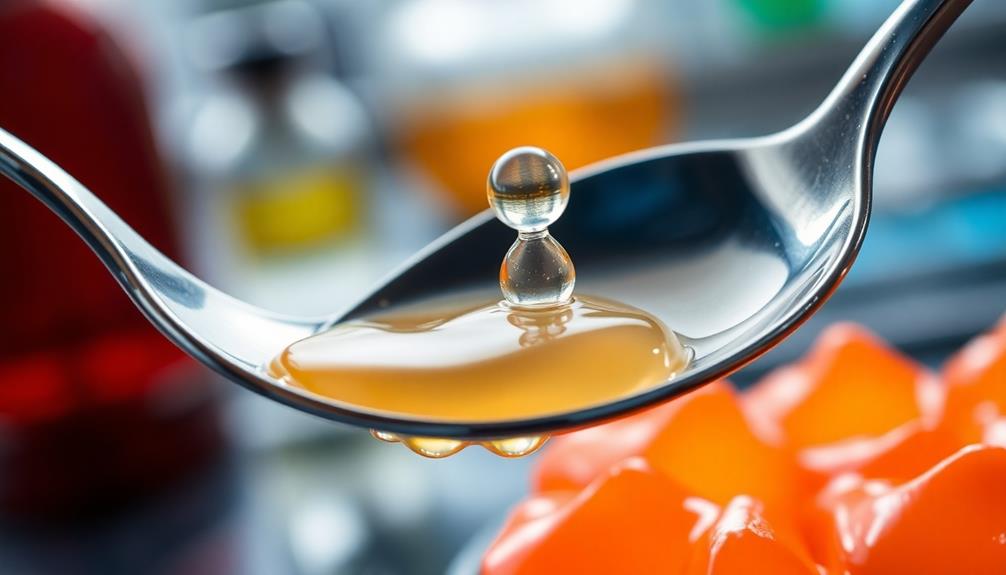
Saliva isn't just moisture; it's essential for how you experience texture in food. Its lubricating effect helps reduce friction, while the proteins in your saliva interact with food components to enhance flavor and mouthfeel.
For instance, the unique textures of traditional Brazilian dishes like Caldeirada can be influenced by how saliva interacts with their rich ingredients.
You might also notice that your unique salivary composition can lead to different texture perceptions compared to others.
Saliva's Lubrication Effect
In the intricate dance of flavors and textures, saliva plays a pivotal role by forming a lubricating layer in your mouth. This slick coating markedly influences your perception of mouthfeel, enhancing your overall eating experience. Salivary proteins, particularly mucins, contribute to this lubrication, protecting your oral surfaces and altering how you perceive texture when chewing.
As food interacts with saliva, it affects flavor perception. Saliva acts as a solvent, helping release both volatile and non-volatile compounds essential for taste. This means that the way you taste your food is intricately linked to the lubrication provided by saliva.
Additionally, variability in salivary properties—affected by age, health, and medication—can lead to different mouthfeel experiences among individuals, which can impact how much you enjoy your meal.
The mucosal pellicle formed by saliva reduces friction during mastication, allowing for smoother oral processing. This enhancement of mouthfeel is vital when savoring various foods and beverages.
Protein Interaction With Food
Food's texture is profoundly influenced by the interaction of salivary proteins with its components. When you eat, salivary proteins, particularly mucins, form a mucosal pellicle that reduces friction, enhancing the smoothness of what you're tasting. This protein interaction is essential for the lubrication of oral surfaces, markedly impacting your sensory experience during meals.
As you enjoy different foods, the binding of salivary proteins to various compounds, such as phenolics in red wine, can create astringent sensations. This results in that puckery or rough texture, which can alter how you perceive flavors. Your age, health, and even medications can change your saliva's properties, leading to varied mouthfeel experiences among individuals. If you have specific tactile sensitivities, this variation can be particularly noticeable.
Moreover, saliva acts as a solvent for both volatile and non-volatile compounds, which means it plays a critical role in enhancing food tastes. The better these proteins interact with food components, the more pleasurable your overall tasting experience becomes.
Understanding these interactions is key in molecular gastronomy, where manipulating textures can elevate your culinary encounters.
Texture Perception Variability
The variability in how we perceive texture during eating is considerably influenced by the properties of saliva. Saliva forms a lubricating layer in your mouth, interacting with food components and enhancing the overall mouthfeel. This mucosal pellicle reduces friction while you chew, making the sensory experience of different textures more enjoyable.
Salivary proteins, especially mucins, play a key role in lubrication and protection of oral surfaces, which directly impacts texture perception. However, individual differences in salivary properties can lead to varying mouthfeel experiences. Factors such as age, health, and medication can affect saliva production and composition.
Here's a brief overview of how saliva influences texture perception:
| Factor | Impact on Mouthfeel |
|---|---|
| Salivary Composition | Alters lubrication and flavor release |
| Age | Changes in saliva viscosity and quantity |
| Health Status | Conditions affecting saliva production |
Unique Textures in Cuisine
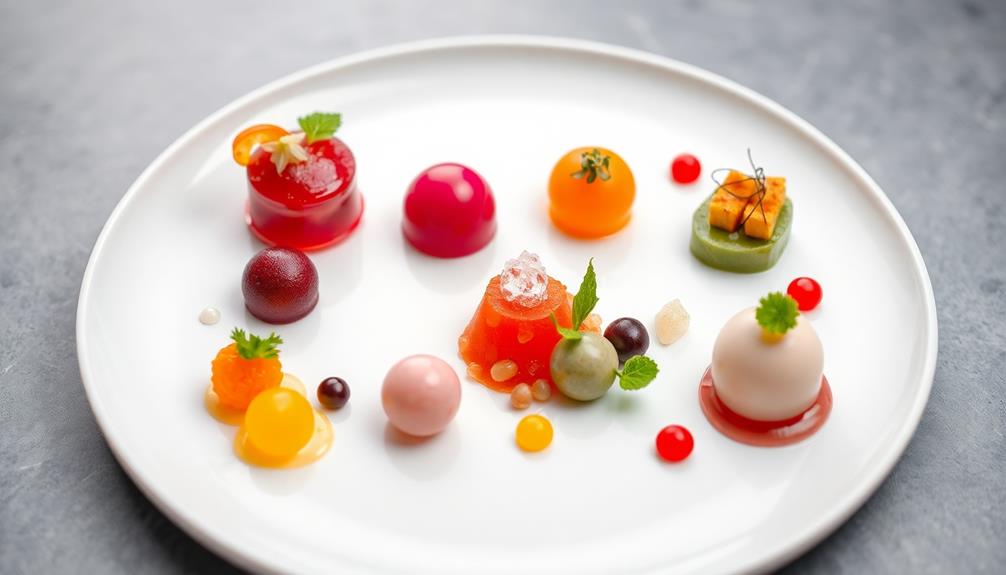
Textures elevate culinary experiences, transforming a simple meal into a memorable event. Unique textures play a vital role in how you perceive flavors and enjoy your food. For instance, the silky mouthfeel of shirako or the tender juiciness of sous vide beef brisket can create delightful contrasts that enhance your dining experience.
When you bite into crispy fried foods or indulge in a smooth dessert, these textural elements evoke emotional responses, shaping your preferences and sometimes leading to dish rejection if expectations aren't met.
Food science reveals that the interplay of various textures in a dish can elevate its overall appeal. Combining crispy and tender components creates a dynamic mouthfeel that excites your palate. Research indicates that creamy textures can enhance perceived richness, especially with a delightful pairing like vanilla and cream.
Understanding the science behind these unique textures, including the impact of microscopic structures and fat distribution, allows chefs to innovate and manipulate textures for maximum enjoyment.
Scientific Insights on Mouthfeel
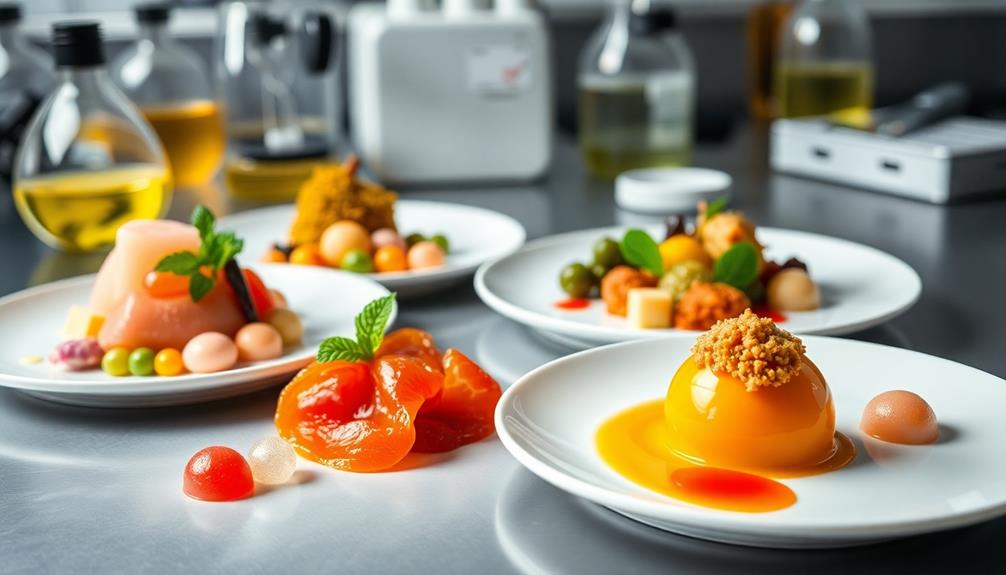
Understanding how unique textures influence your dining experience naturally leads to investigating the science behind mouthfeel. Mouthfeel is a complex sensory experience, shaped by tactile sensations like creaminess, viscosity, and temperature, all of which greatly impact your flavor perception and enjoyment of food or beverage.
The interaction of saliva with food components is vital. Salivary proteins like mucins provide lubrication, enhancing how flavors are perceived. Astringency is another key aspect, stemming from the binding of salivary proteins with phenolic compounds, often experienced as dryness, particularly in red wines.
Research shows that the size and distribution of fat droplets also affect mouthfeel. Irregularly shaped fat networks, like those in foie gras, create a firmer texture compared to smoother products like pâté. Advances in techniques such as coherent anti-Stokes Raman scattering (CARS) microscopy are allowing chefs to explore deeper into the microscopic structures that influence food texture.
| Sensory Aspect | Description | Example |
|---|---|---|
| Creaminess | Smooth, rich texture | Ice cream |
| Viscosity | Thickness and flow resistance | Honey |
| Astringency | Dryness from tannins | Red wine |
| Fat Distribution | Size and shape of fat droplets | Foie gras vs. pâté |
| Temperature | Warmth or chill affecting taste | Hot soup |
Consumer Preferences for Texture

While you might focus on flavors when choosing a meal, the texture of food plays an essential role in your overall satisfaction. Consumer preferences for texture greatly influence your food choices. You often expect familiar textures based on the food type, which can greatly impact your enjoyment and acceptance of dishes.
For instance, if you encounter tough meat or soggy fries, you might reject the dish altogether, underscoring how important texture is in your dining experience.
Texture also evokes emotional responses. Certain textures are prioritized in specific cuisines, shaping your dining experiences and preferences. You'll notice that your comfort with textures can vary based on cultural backgrounds, influencing culinary trends. People from different regions might've distinct tolerances for various mouthfeel sensations, which further affects what you enjoy.
Interestingly, many consumers rate the quality of texture higher than flavor in their dining experiences. You likely find yourself drawn to rich, pleasing mouthfeels that drive your selection of indulgent foods.
In this way, understanding consumer preferences for texture can enhance not only your meals but also the overall experience of dining.
Culinary Techniques for Texture
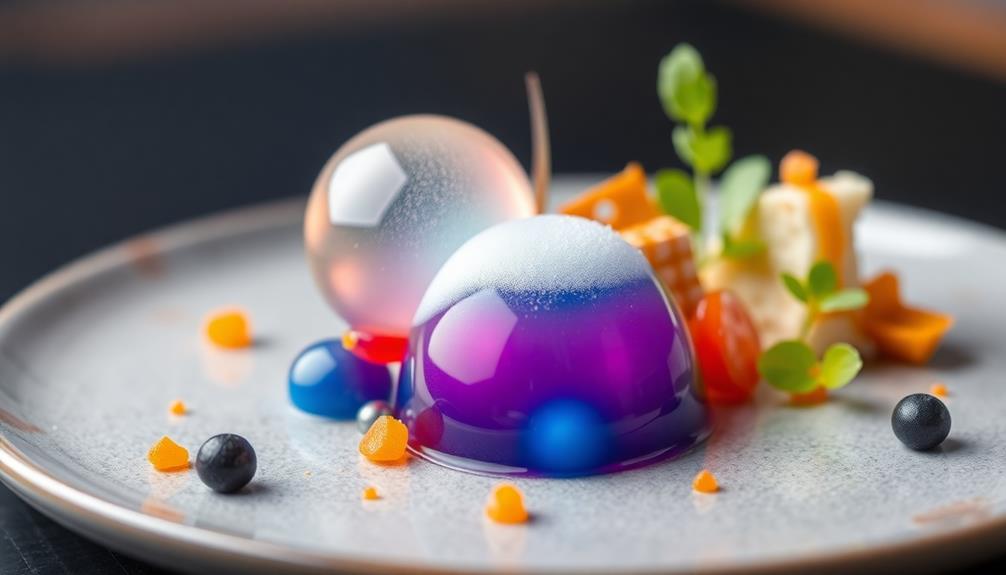
When it comes to creating memorable dining experiences, culinary techniques play a pivotal role in enhancing texture. By understanding and applying these techniques, you can elevate the mouthfeel of your dishes, making every bite unforgettable.
Here are four key methods that can transform your culinary creations:
- Sous Vide Cooking: This technique allows you to precisely control temperature, resulting in tender and juicy dishes that enhance mouthfeel.
- Textural Contrasts: Pairing crispy elements with creamy components engages multiple sensory pathways, creating a dynamic dining experience.
- Foaming and Spherification: Manipulate the texture of liquids to produce light, airy sauces or bursts of flavor in small spheres, offering unique mouthfeel experiences.
- Emulsification: Create stable mixtures of oil and water to achieve creamy textures in sauces and dressings, enriching overall mouthfeel.
Frequently Asked Questions
What Is the Science Behind Molecular Gastronomy?
Molecular gastronomy combines culinary arts with scientific principles to transform food preparation. You explore chemical reactions, ingredient interactions, and innovative techniques, enhancing flavors and textures, creating unique dining experiences that engage all your senses.
What Is the Science Behind Food Texture?
Imagine a symphony of sensations; food texture shapes your experience. It's a dance of microscopic structures and fat distribution, where touch, taste, and sound intertwine, influencing your enjoyment and choices with every delightful bite.
Why Is Texture or Mouthfeel Important in the Entire Eating Experience?
Texture's essential in your eating experience because it shapes how you perceive flavors and aromas. Whether it's creaminess or crispiness, these sensations evoke emotional responses, making every bite more enjoyable and memorable for you.
Where Did Mouthfeel Come From?
Mouthfeel originated as a term describing the tactile sensations you experience while eating or drinking. It's shaped by cultural influences, individual experiences, and the textures that evoke different responses in your palate and enjoyment.
Conclusion
In exploring the science behind mouthfeel, you discover how texture influences your dining experience, how saliva enhances flavors, and how unique culinary techniques can elevate a dish. By understanding astringency and its impact on taste, you can appreciate the artistry behind molecular gastronomy. As you savor each bite, remember that a dish's texture can surprise, delight, and transform your palate, making every meal not just an experience, but a journey of flavor and sensation.
